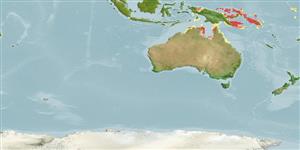>
Ovalentaria/misc (Various families in series Ovalentaria) >
Pomacentridae (Damselfishes) > Pomacentrinae
Etymology: Amphiprion: Greek, amphi = on both sides + Greek, prion, -onos = saw (Ref. 45335).
Environment: milieu / climate zone / depth range / distribution range
Écologie
marin récifal; non migrateur; profondeur 2 - 12 m (Ref. 9710). Tropical; 1°S - 25°S
Western Central Pacific: Papua New Guinea, Manus Islands, D'Entreceasteaux Islands, New Britain, and Solomon Islands.
Taille / Poids / Âge
Maturity: Lm ? range ? - ? cm
Max length : 12.0 cm TL mâle / non sexé; (Ref. 90102)
Description synthétique
Clés d'identification | Morphologie | Morphométrie
Épines dorsales (Total) : 9; Rayons mous dorsaux (Total) : 18 - 19; Épines anales: 2; Rayons mous anaux: 13 - 14.
Adults inhabit lagoons and outer reef slopes. Oviparous, distinct pairing during breeding (Ref. 205). Eggs are demersal and adhere to the substrate (Ref. 205). Males guard and aerate the eggs (Ref. 205). This species may be a hybrid between A. chrysopterus and A. sandaracinos. A. thiellei may be a similar hybrid (Ref. 90102). Associated with the anemones: Heteractis crispa, Heteractis magnifica, and Stichodactyla mertensii (Ref. 5911). Has been reared in captivity (Ref. 35420).
Life cycle and mating behavior
Maturities | Reproduction | Spawnings | Egg(s) | Fecundities | Larves
Oviparous, distinct pairing during breeding (Ref. 205). Eggs are demersal and adhere to the substrate (Ref. 205). Males guard and aerate the eggs (Ref. 205). Also Ref. 7471.
Allen, G.R., 1991. Damselfishes of the world. Mergus Publishers, Melle, Germany. 271 p. (Ref. 7247)
Statut dans la liste rouge de l'IUCN (Ref. 130435)
Menace pour l'homme
Harmless
Utilisations par l'homme
Pêcheries: commercial; Aquarium: Commercial
Outils
Articles particuliers
Télécharger en XML
Sources Internet
Estimates based on models
Preferred temperature (Ref.
123201): 27.4 - 29.5, mean 28.9 °C (based on 236 cells).
Phylogenetic diversity index (Ref.
82804): PD
50 = 0.5000 [Uniqueness, from 0.5 = low to 2.0 = high].
Bayesian length-weight: a=0.01479 (0.00642 - 0.03409), b=3.00 (2.80 - 3.20), in cm total length, based on LWR estimates for this (Sub)family-body shape (Ref.
93245).
Niveau trophique (Ref.
69278): 2.7 ±0.31 se; based on food items.
Résilience (Ref.
120179): Haut, temps minimum de doublement de population inférieur à 15 mois (Preliminary K or Fecundity.).
Fishing Vulnerability (Ref.
59153): Low vulnerability (10 of 100).
Nutrients (Ref.
124155): Calcium = 115 [66, 184] mg/100g; Iron = 0.806 [0.505, 1.250] mg/100g; Protein = 18.7 [17.6, 19.7] %; Omega3 = 0.134 [0.086, 0.211] g/100g; Selenium = 19.5 [11.7, 34.4] μg/100g; VitaminA = 129 [45, 378] μg/100g; Zinc = 2.06 [1.45, 2.83] mg/100g (wet weight);
